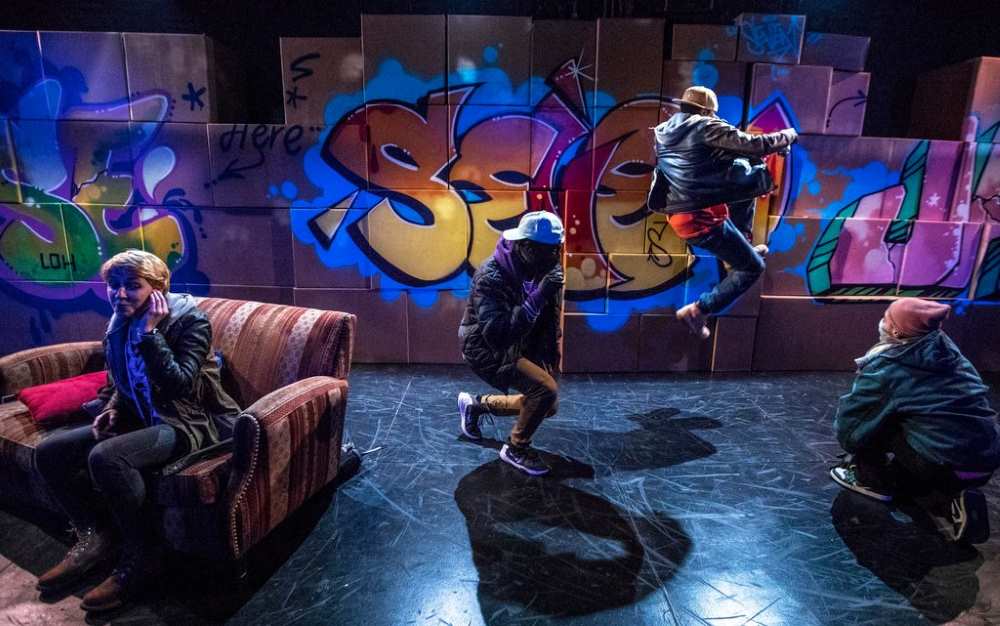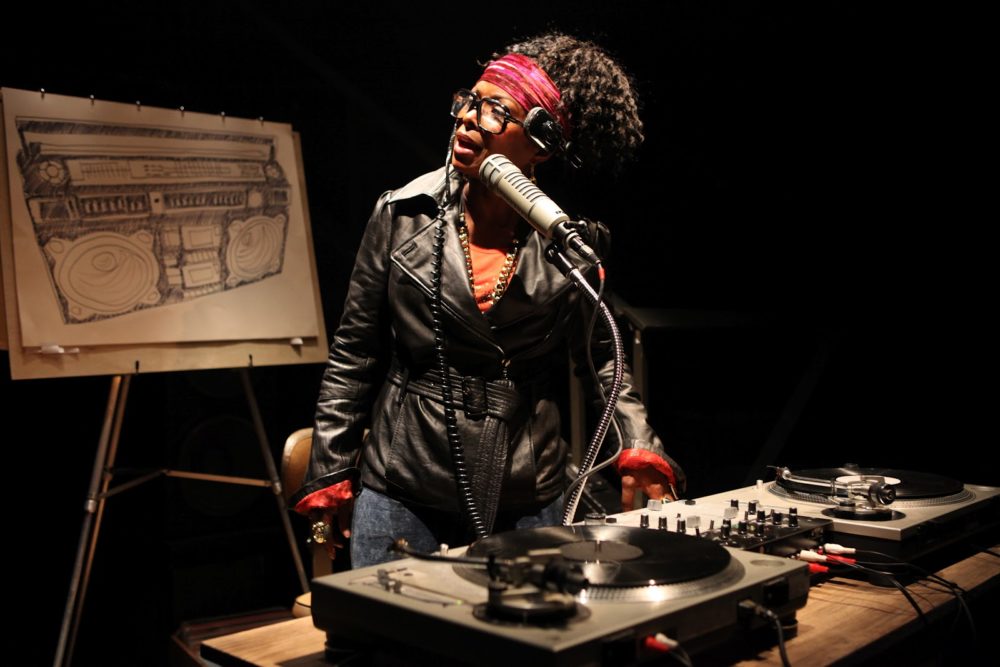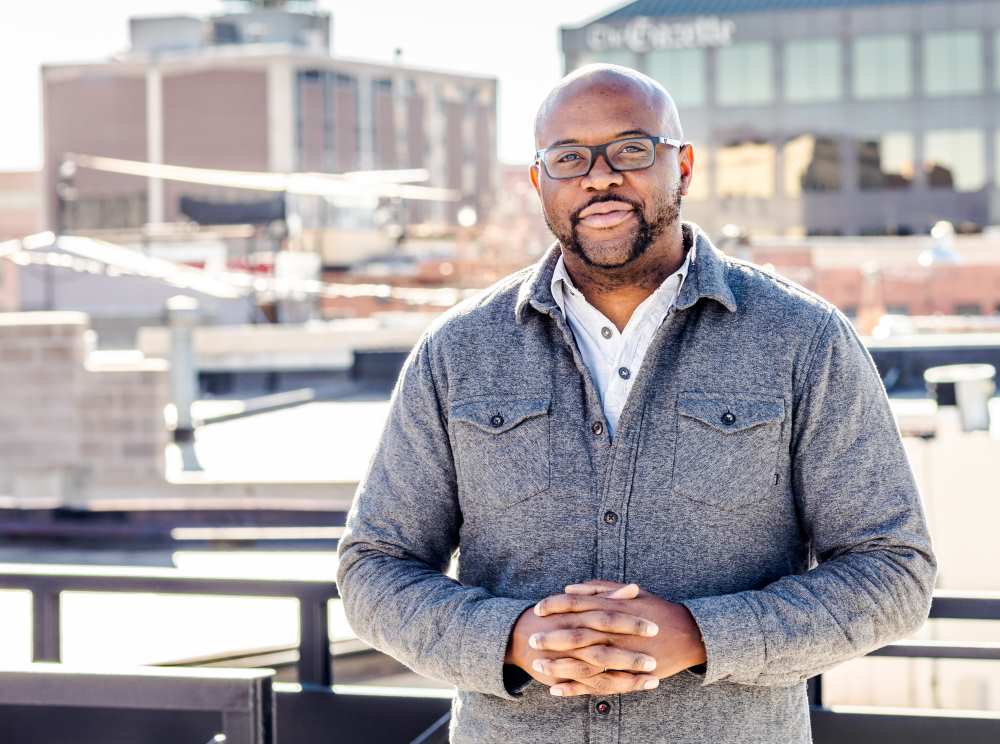Each time playwright Idris Goodwin sees the hip-hop supergroup the Roots, he has an epiphany. First when he was 17, again at 24, and then at 30. Each of these performances became for Goodwin “a moment of clarity and purpose.” Considered by many to be the greatest live hip-hop band ever, the Roots are legendary for their authenticity and creativity in a genre that prizes both above all else. “Every time I see them I have a feeling where I’m like, ‘That is what excellence looks like,’ and I want to be at that level of truth and realness,” Goodwin explains.
Like the Roots, Goodwin has the contemporary rhythms of language in his bones, and he brings them to the stage as both a performer and playwright. He grew up absorbing hip-hop culture in Detroit and became serious about it as a young rapper in Chicago. He carries a natural performer’s magnetism with him, whether he’s onstage making music or in the classroom leading a creative writing discussion. Though not a large man, he commands space by filling it with a direct, engaging vibe. Wherever he goes, and whatever form his work takes, Goodwin lights up rooms with his energy, humor, and enthusiasm.
“I feel like it’s possible for me to do anything—it’s all just telling stories,” he says.
Like much of the best hip-hop, Goodwin’s plays dive into contemporary social cultural issues and U.S. history. The 41-year-old now has 14 plays under his belt, and has been produced all over, including How We Got On (first seen at the Humana Festival of New American Plays at Actors Theatre of Louisville, and subsequently produced around the country), Bars and Measures, The Raid, and Blackademics.
“There is an assumption of a world of possibilities in his characters that is deeply uncynical,” says Alison Carey, who commissioned his newest work, The Way the Mountain Moved, as part of the Oregon Shakespeare Festival’s American Revolutions History Cycle. The play receives its world premiere at OSF July 10 through Oct. 28. “There is a strength in his characters, who are open to possibility, which is delightful,” Carey says.
Coming up is Goodwin’s This Is Modern Art, co-written with Kevin Coval, which had a contentious premiere in Chicago in 2015 and is currently running at New York Theatre Workshop June 2-23 (in a production by New York City’s Blessed Unrest); HYPE MAN: a break beat play at Philadelphia’s InterAct Theatre Company in January 2019; and the youth show And in This Corner: Cassius Clay, playing at Seattle Children’s Theatre this fall after runs at various other TYA venues.
Indeed several of Goodwin’s plays have been tailored for young audiences: And in This Corner introduces us to the 12-year-old boxer who would become Muhammad Ali. This summer the writer will double down on this youth focus as he becomes the producing artistic director of StageOne Family Theatre in Louisville, Ky., which commissioned and premiered Cassius Clay. “I was just ready to spread my wings in a different direction, and I wanted to go back to nonprofit work, community building, outreach,” Goodwin says of the move.
As he’s moved into theatre, Goodwin hasn’t entirely left behind doing hip-hop for real. He has five rap albums, available at idrisgoodwin.bandcamp.com, including Rhyming While Black, the compilation Kings for the Night, and Break Beat Poems.
“Black art is inherently about disruption—that’s what jazz is, that’s what hip-hop is,” he says. “It’s all in this continuum of us finding ways to use art to be free.”

Goodwin was raised in Detroit and its suburbs. His father was an auto industry executive and his mother worked in urban planning. He moved to Chicago when he was 19, where he had his “cultural awakening.”
“I was in bands, I was making films, I was doing plays—just moving,” he recalls. There was never a question in his mind that he would be an artist. “I knew I was creative and I knew I wanted to be around other creative people,” he explains.
He credits his time in Chicago for instilling a clear-eyed work ethic to buttress his artistic sensibility. If hip-hop has been Goodwin’s heartbeat, Chicago’s own Lorraine Hansberry was his theatre lifeblood. He calls her “the greatest American playwright. A Raisin in the Sun is a perfect piece of drama and theatre. Such richness and dimension.”
Goodwin received his bachelor of arts degree in film, video, and screenwriting from Columbia College, and a master of fine arts in creative writing from the School of the Art Institute of Chicago. For the last five years, he’s taught creative writing and hip-hop aesthetics at Colorado College.
Goodwin intends for his work to create engagement and discussion. The conversation has occasionally been heated. This Is Modern Art created a kerfuffle when it premiered in 2015 at the Steppenwolf Theatre Company as part of its theatre for young adults lineup. Based on actual events—the 2010 graffiti tagging of the relatively new wing of the Art Institute of Chicago—the play got no love from the city’s two major newspaper critics, who complained that the play glorified vandalism by the predominantly African American graffiti crew. Wrote Chris Jones in the Chicago Tribune: “Graffiti can be inartful, for goodness’ sake. More importantly yet, graffiti had the effect of making people feel unsafe in the city. It terrified people.”
Jones and the Chicago Sun-Times’ critic, Hedy Weiss, were summarily skewered via social media by the Chicago theatre community and beyond for purportedly missing the play’s ideas about the nature of art, representation, and race.
Goodwin generally steered clear of any public statements about the controversy. “I knew we’d get reactions that mirrored the very same reactions to the incident that we wrote about,” he remarks. “What I wasn’t expecting was how vocal the theatre community would be in protest to the reviews. Obviously Kevin and I were both honored by the support.”
Goodwin calls some of his stage work “breakbeat” plays—breakbeat, widely considered the rhythmic foundation of hip-hop, refers to the way early hip-hop DJs used the turntable to improvise with drum breaks. These plays—How We Got On, The Realness, and HYPE MAN—are based in the elemental aesthetics of hip-hop art, and are about hip-hop in both form and content.
The playwright calls them “musical plays that are not musicals.” Instead they’re plays in which hip-hop is baked into the skeleton of the work, even when the characters are speaking. He explains that “this includes the integration of rap (all three plays have rap in them); turntablism (in How We Got On, the DJ/narrator blends scenes together, and uses the cast as if they were sample sounds), beatboxing (again, How We Got On), beat production (HYPE MAN), call and response, and so on.”
The “breakbeat” plays began with How We Got On, Goodwin’s most-produced work to date. In that play, middle-class black teenagers navigate the early days of hip-hop while searching for their identities at an age when the questions can be vague and answers elusive. Alongside the characters’ stories, the play provides a running history of the sonic innovations of hip-hop.
Goodwin uses the play’s DJ, Selector, as the primary storytelling engine. In the tradition of classic old-school DJs of hip-hop (such as Kool Herc and Grandmaster Flash), Selector sets the sonic tone, gives the audience information, and commands and reacts to the characters. An illustrative snippet:
(Selector puts on “Pungee” by the Meters. Over “Pungee”:)
SELECTOR: Battle rhymes.
When you start—drop a lot of popular nouns—words people will know but be surprised to hear—they’ll be like
Oooooohhhhsnapp!!
say the other guy is not actually a guy at all
say you got intimate with his mother. Or his sister.
Use techniques like metaphor
HANK: If rap was a shoe, you’d be a sandal
SELECTOR: Simile
HANK: Black and heavy, just like an anvil
Goodwin hit on the idea of the “breakbeat” plays while conversing with his friend Coval, his This Is Modern Art co-writer.
“We were trying to figure out: Who are we? What are we doing?” Goodwin says. He decided the question of identity came down to the breakbeat. “Taking the stripped-down, percussive rhythmic nature of a song and looping it is the marker of us as writers,” Goodwin says. When writing those plays, he was looking for “that raw, stripped-down nature that makes you do the ‘ugly face.’”
Adding the moniker “breakbeat” tells audiences they’re about to see something unapologetically informed by the now-ubiquitous stream of popular culture. Goodwin also hopes these works explore how America has evolved in response to the new art form.
Buck Busfield, producing artistic director of B Street Theatre in Sacramento, Calif., who directed an early production of How We Got On, enthuses, “I just thought it was a beautiful piece of theatre. When was the last time you saw a play stop dramatic action and get into the technical advancements of sound? That’s just audacity. He did it successfully and kept it interesting dramatically.”
Busfield and Goodwin share a love of music, which led to their collaboration on Bars and Measures. The inspiration came from a New York Times article Busfield read about two very different African American brothers. He forwarded the piece to Goodwin, who then wrote the play about one brother who plays jazz bass and may have become involved in a terrorist cell, and the other, a classically trained pianist, who tries to get his brother exonerated. It premiered at B Street in 2015, supported by the National New Play Network, and was then produced around the country.

May Adrales, who is directing The Way the Mountain Moved at OSF (July 10-Oct. 28), says that as different as Goodwin’s plays seem, they have a common element. “The words leap off the page,” Adrales marvels in an email. “His writing is vibrant, musical, rhythmic, and daring.” But it’s not just his form—it’s also his content. “He’s also deeply curious and has a strong sense of justice,” she notes. “He addresses those issues in his plays.”
For example, in the one-act play #matter, two longtime friends—one white, one black—share different interpretations of the Black Lives Matter protests. HYPE MAN features an interracial hip-hop trio on the verge of a commercial breakthrough when they have conflicting reactions to the police shooting of an unarmed black teenager.
While breakbeats and cultural dynamics have often informed Goodwin, he is also a student of history. His play The Raid deals with the armed insurrection led by John Brown in 1859. In American Tales, he connects American folktales to the communities they originated from. And in This Corner explores how racism and Jim Crow laws affected the young Clay/Ali in Louisville in the 1940s.
That made his OSF American Revolutions commissions a natural fit (the series has birthed such well-known works as Sweat by Lynn Nottage and All the Way by Robert Schenkkan). In Goodwin’s case, it was pre-Civil War history that inspired the environmentally themed The Way the Mountain Moved. The play takes place in the mid-1850s. It examines the crossed paths of U.S. Army surveyors seeking the best route for the Transcontinental Railroad, Native Americans whose land will be consumed by the project, and African American Mormons seeking a safe homestead. Goodwin says the raw historic material—rough travelogues, maps, and illustrations—was rich with conflicting intentions and interests.
“America means so many different things to so many specific different cultural groups across race, religion, and ideology,” he explains. “They’re driven by the same thing: this desire for discovery and freedom. What happens when they collide around those different objectives?”
Adrales, who directs the sprawling tale of Manifest Destiny, says that the play “reframes that narrative by capturing what the West really was. It’s a collision of people from vastly different backgrounds, who more often had to work together, rather than reach for the gun, to survive.”
It’s also a play in which Goodwin can address his “love/hate” relationship with the Western genre. While these stories often glorify one culture and mythology at the expense of others, they also have a compelling feeling of action and adventure. Accordingly Goodwin doesn’t set out to satirize or send up Westerns; he wants to find his own way into the canon, as someone who rarely saw himself represented in the genre. “This became the study of looking at all the multiplicities that America has, and these conflicts have been in us from the beginning,” he says. “That’s the moment we’re still in.”
Goodwin will continue melding theatre and music in his next projects: an immersive hip-hop piece for the Denver Center and a play about the early life of Jimi Hendrix for Seattle Children’s Theatre. After opening his play in Ashland, Goodwin will move with his wife and son to Louisville, where his focus will be on running StageOne and on raising its national profile through creative programming and developing new work.
“It’s how we begin to cultivate a new generation of theatre-fluent people onstage and off the stage,” Goodwin says. “We need to be listening to each other and learning more about each other. Theatre and the performing arts are positioned to be a leader in that discourse.”
Marcus Crowder is an arts and culture writer based in Northern California. For 17 years he was the theatre critic at the Sacramento Bee.


